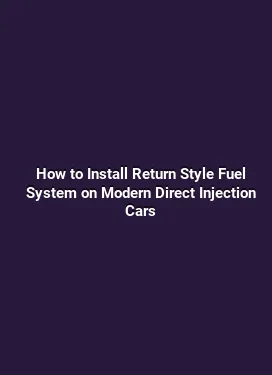The Necessity of Fuel Injector Dead Time and Latency Compensation in Custom Tunes
Modern performance engines rely on precise control of air and fuel to achieve optimal power, efficiency, and drivability. When customizing tunes for intake and fuel systems, understanding the nuanced behaviors of fuel injectors becomes essential. Two often overlooked concepts—injector dead time and latency compensation—play a pivotal role in translating tuned maps into real-world engine performance. This article delves into how these phenomena influence fueling accuracy, the steps to implement compensation, and practical examples from common tuning scenarios.
Understanding Injector Dead Time: What It Is and Why It Matters

Injector dead time, sometimes referred to as injector pulse width nonlinearity, is the brief period after a commanded current is removed during which the injector remains closed. This delay is not merely a fixed number; it varies with ambient temperature, fuel temperature, fuel pressure, and injector design. In a simplified sense, even if the ECU requests a certain fuel flow by controlling the pulse width, the actual amount delivered can deviate due to the time it takes for the injector to physically open and close. The impact becomes more pronounced at higher engine speeds or when throttle events demand rapid transitions between lean and rich mixtures.
From a practical perspective, dead time shifts the fuel delivery curve toward smaller open times, effectively causing a small but meaningful under-delivery at short pulse widths. For engines with aggressive cam profiles, high intake manifold pressures, or forced induction, this discrepancy can translate into noticeable drivability issues, such as tip-in hesitation, transient lean conditions, or thermostat-like fluctuations in idle stability. Correcting for dead time helps align the commanded EFI maps with the actual fueling behavior across the RPM range and load spectrum.
Latency in Fuel Injectors: The Temporal Gap Between Command and Delivery
Latency encompasses the broader delay from the moment the ECU issues a fuel command until the fuel actually reaches the combustion chamber. This delay includes electrical signal propagation, coil energization, nozzle opening, and the mechanical response of the injector plunger. Latency is influenced by injector construction (side-held vs. top-fed), number of solenoids, coil resistance, and the dynamics of the fuel delivery system, such as rail pressure and line impedance. In high-performance setups, latency can become a limiting factor when attempting to sustain precise volumetric fueling at high RPMs, especially during rapid-duty cycles like gear changes or sudden acceleration.
Latency compensation is the process of adjusting the fueling maps to account for these delays so that the actual air-fuel ratio (AFR) aligns with the target value. Without compensation, engines may run consistently richer or leaner than intended in specific cells of the map, leading to reduced power, increased emissions, or potential detonation risk in boost-heavy configurations. Proper latency handling ensures that transient responses remain consistent and predictable across driving scenarios.
Integrating Dead Time and Latency Compensation into a Tuning Strategy
Implementing effective compensation requires a structured approach. The following steps outline a practical workflow that can be adapted to a wide range of intake and fuel system configurations, from natural aspiration to turbocharged and supercharged builds.
Step 1: Baseline Mapping and Diagnosis

Begin with a robust baseline map derived from the engine’s stock fueling characteristics, then introduce gradual modifications to the intake system or fuel pressure to observe how the engine reacts. Use data logging to observe AFR, injector duty cycle, RPM, load, and transient events. Pay attention to short-pulse-width regions where dead time typically has the largest relative impact. This initial phase helps establish a reference against which compensation can be measured.
Diagnostics should include a comparison between commanded fuel and actual fuel delivery under steady-state and transient conditions. If the engine shows noticeable lean spikes under quick throttle transitions or at idle while the injector duty cycle is low, dead time and latency may be contributing factors. Document these occurrences with time-correlated logs so future adjustments can be correlated to specific cells in the map.
Step 2: Quantifying Dead Time
Quantification involves isolating the injector’s nonlinearity at low duty cycles. One practical method is to compare measured AFR at very low pulse widths across a range of temperatures and pressures. A consistent phase lag or under-delivery at short pulse widths signals notable dead time. Some tuners implement a fixed dead time value per injector, while others build a temperature- and pressure-dependent function to reflect real-world conditions. The chosen approach should be kept consistent to avoid introducing new sources of error when the engine operating envelope shifts.
In many systems, dead time increases slightly with injector wear or aging. For high-mileage builds, periodic re-validation of dead time is advisable to maintain accuracy. When evaluating dead time, it is essential to consider coil resistance and supply voltage, as these factors can subtly modulate the effective opening time of the injector during the time window the ECU applies the current.
Step 3: Deriving Latency Correction Models
Latency models translate physical delays into the ECU’s fueling strategy. A practical model relates latency to current operating conditions such as RPM, load, and rail pressure. A common approach is to apply a per-cell latency offset that compensates for the average delay observed under those conditions. Advanced setups may use dynamic latency compensation that updates in real time based on engine speed and sensor feedback, thereby preserving accuracy in transient events like rapid throttle blips or gear shifts.
When constructing a latency model, ensure it does not introduce instability during rapid transitions. Implement safeguards to prevent aggressive corrections in cells that already have high variability due to sensor noise or transient fuel pressure fluctuations. The objective is to smooth out the discrepancy between commanded and actual fueling while preserving the integrity of the transition behavior.
Practical Techniques for Implementing Compensation in Common Scenarios
The following scenarios illustrate how dead time and latency compensation can be applied in real-world tuning projects. Each example emphasizes practical adjustments, measurement strategies, and expected outcomes rather than theoretical concepts alone.
Scenario A: Naturally Aspirated Intake Upgrades
Upgrading the intake path—such as larger runners, high-flow filters, or improved plenum design—can reduce intake restrictions and influence velocity stacks. While these changes can increase power, they may also alter the dynamic fuel requirements, especially at low to mid RPM where idle stability and part-throttle response matter. Implement a modest dead time correction to the lower pulse-width cells to offset the slightly earlier onset of fuel delivery. Pair this with a latency map that slightly attenuates corrections at high RPM where injector latency tends to be more pronounced. The goal is a smooth, predictable response without sacrificing throttle feel or idle stability.
Measure AFR during steady-state cruise and during quick throttle movements to verify improvements in transient behavior. A well-tuned setup will exhibit less lean fluctuation during rapid throttle transitions and a more consistent AFR at light loads.
Scenario B: Forced Induction and Boosted Applications
Boosted engines place higher demands on fueling precision due to elevated air delivery and the risk of detonation. The combination of higher rail pressure and increased injector duty cycle means dead time and latency can have amplified effects on the actual fuel delivered per cycle. Implement a more sophisticated latency compensation that scales with boost pressure and RPM. Also, calibrate dead time to account for the lower effective pulse width observed during transient boost conditions. In practice, this often means a broader compensation envelope with slightly higher offsets at the lower to mid RPM range where dwell time matters most.
In data logs, monitor AFR stability during boost onset and late-stage boost transitions. A successful calibration maintains a stable AFR with minimal overshoot or undershoot, supporting consistent power delivery and reducing the likelihood of knock events in aggressive tunes.
Scenario C: High-Flow Injectors and Wide-Open Throttle Tuning
With high-flow injectors, the total fuel mass can be delivered more rapidly, but the intrinsic timing delays remain relevant, particularly at very high engine speeds. Here, latency compensation can be more pronounced in the upper cells of the map, ensuring that the rapid injector response translates into accurate fueling. A practical approach is to implement directionally tuned latency offsets that increase slightly with RPM but do not overcompensate in lean regions where air density and cooling effects influence engine behavior.
Additionally, validate fuel pressure stability during high-demand events. A drop in rail pressure can mimic a latency effect by reducing actual fuel delivery timing. Correlate compensation with sensor data from rail pressure and temperature to preserve a robust and repeatable fueling strategy across the entire operating envelope.
Testing, Validation, and Continuous Improvement
Compensation strategies must be validated under diverse driving conditions. Road testing combined with on-vehicle data logging provides the most relevant feedback. Emphasize repeatability: the same acceleration and deceleration profiles should yield consistent AFR outcomes across multiple trials. If variability persists, re-evaluate sensor calibration, connection integrity, and the physical condition of the injectors and fuel rails.
Software tools that support per-cell or per-bin compensation enable a granular approach to fine-tuning. When deploying precise latency and dead time corrections, maintain a changelog and perform systematic rollbacks if a new adjustment degrades performance. In high-power builds, consider safety margins that account for sensor lag, fuel temperature shifts, and the potential influence of atmospheric pressure on engine behavior.
Advanced Considerations: Trends, Semantics, and Real-World Relevance
As the field of engine tuning evolves, several concepts reinforce the importance of accurate timing in fueling strategies. Trend terminology such as dynamic compensation, map refinement, and closed-loop calibration reflects a shift toward responsive, data-driven tuning philosophies. Semantically, the focus moves from static, one-size-fits-all maps to adaptive models that reflect real-time engine state, sensor feedback, and environmental conditions. This direction aligns with modern vehicle control architectures that prioritize precision fueling for efficiency and performance without sacrificing reliability.
In practice, the combination of dead time and latency compensation enables a broader range of intake and fuel system configurations to perform predictably. Whether adapting to varied fuel types, alternative fuels, or custom turbo manifolds, the ability to quantify and compensate for injector timing behavior is a foundational capability for professional tuners. The end result is a more linear, controllable power curve and a more forgiving, consistent driving experience across daily and track use.
Best Practices for Documentation and Collaboration
Document all compensation parameters with clear annotations about the operating conditions under which they were derived. Keep examples of before-and-after logs that illustrate how dead time and latency corrections shift fuel delivery in key cells of the map. Collaboration with calibration engineers, fuel system specialists, and dyno technicians accelerates the validation process and reduces the risk of unintended consequences when deploying new tunes.
Regularly revisit compensation as part of maintenance or after major system changes. Aging injectors, variations in fuel quality, or modifications to the intake and forced induction setup can alter timing behavior enough to necessitate recalibration. Establish a routine that includes re-running controlled tests and updating the compensation model to reflect the engine’s current state.






